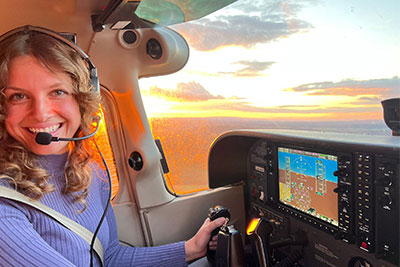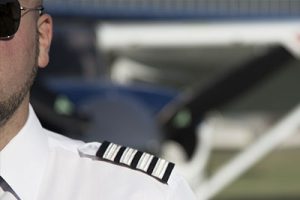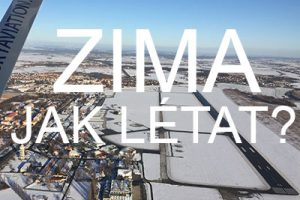For flight organizations, scenic/sightseeing flights are an interesting option to raise public awareness about themselves. Let’s discuss the legislative requirements for conducting “scenic flights” so that the company operating them does not run afoul of the legal regulations, which are particularly stringent in the aviation sector.
Sources: The following text is compiled based on information and materials from the law firm Vych & Partners, s.r.o. for Blue Sky Aviation s.r.o.
“Scenic Flights”
Neither national nor European legislation recognizes the term “scenic flight.” However, the phenomenon of scenic flights is regulated as an “introductory flight.” An introductory flight is any short flight operated for a fee or other consideration by an organization for training listed in Article 10a of Commission Regulation (EU) No 1178/2011, or an organization created for the purpose of promoting sport or recreational flying with the aim of gaining new members or individuals interested in training.
The essence of introductory flights is that they can be conducted even by entities that do not hold a license for commercial air transport, the primary purpose of which is to carry out flights for third parties for a fee. Obtaining this license is quite challenging, as evidenced by the fact that, for example, in the area of helicopter flying, only four entities have this license, which can be considered the pinnacle in their field in the Czech Republic. Likewise, operating under commercial air transport regulations is subject to numerous additional restrictions and obligations.
Article 6(4a)(c) of COMMISSION REGULATION (EU) No 965/2012 of 5 October 2012, which sets out the technical requirements and administrative procedures related to flight operations pursuant to Regulation (EC) No 216/2008 (the AOC regulation), stipulates that, without meeting the requirements of Articles 5(1) and 6 (i.e., not under commercial air transport rules), introductory flights can be conducted with other than complex motor-powered aircraft and helicopters, either by a training organization whose main place of business is in a Member State and is listed in Article 10a of Regulation (EU) No 1178/2011, or by an organization created for the purpose of promoting sport or recreational flying, provided that the organization operates the aircraft based on ownership or dry lease, that the flight does not generate profit paid out of the organization, and that flights involving persons who are not members of the organization only constitute a marginal activity of the organization.
According to ARO.OPS.300 of Annex II of the mentioned regulation, the national authority (in our case, the Civil Aviation Authority, hereinafter “the Authority”) may establish additional conditions for introductory flights carried out within the territory of a Member State. These conditions must be reasonable and ensure safe operations.
What qualifies as a scenic or introductory flight?
First and foremost, it must be a short flight. Regulations do not specify the maximum length of the flight to qualify as short. In this context, it seems reasonable to require, according to regulation CAA-SL-102-6-16, that it must be a flight that begins and ends at the same airport or the same operational site. This requirement seems quite logical since the purpose of an introductory flight should not be to transport a passenger from point A to point B but to allow them to experience the beauty of flying in an airplane or helicopter. According to the Civil Aviation Authority, it does not define the maximum length of the flight that meets the definition of a “short flight,” unlike some other EASA member states. Thus, it is up to the entity conducting the flight to decide how long the scenic flight will last, making it possible to offer and sell flights of various lengths.
Who can conduct scenic flights?
It is also appropriate to address the entities authorized to conduct an introductory flight. Regulation CAA-SL-102-6-16, in connection with Article 6(4a)(c) of COMMISSION REGULATION (EU) No 965/2012 of 5 October 2012, states that:
“Introductory flights referred to in 1.1 can only be conducted by:
– a training organization approved under Regulation (EU) No 1178/2011 (ATO), or
– declared training organizations according to Regulation (EU) No 1178/2011 (DTO), or
– an organization created for the purpose of promoting sport or recreational flying
provided that the main place of business of the organization is located in one of the Member States and the organization operates the aircraft based on ownership or dry lease, that the flight does not generate profit paid out of the organization, and that flights involving persons who are not members of the organization only constitute a marginal activity of the organization.”
And here, according to the opinion of the law firm Vych & Partners, s.r.o., there is an inaccurate transcription of Article 6(4a)(c) of the above-mentioned regulation, which states that:
“introductory flights, … conducted either by a training organization whose main place of business is located in one of the Member States and is listed in Article 10a of Regulation (EU) No 1178/2011, or by an organization created for the purpose of promoting sport or recreational flying, provided that the organization operates the aircraft based on ownership or dry lease, that the flight does not generate profit paid out of the organization, and that flights involving persons who are not members of the organization only constitute a marginal activity of the organization.”
Therefore, the European regulation’s phrase “whose main place of business is located in one of the Member States” according to the author’s opinion, applies only to ATO and DTO, not to organizations created for promoting sport aviation. However, this may not be the main problem of the provision.
The main interpretive issue of the provision is seen as the part that states: “the flight does not generate profit paid out of the organization and that flights involving persons who are not members of the organization only constitute a marginal activity of the organization.“
Does the aforementioned apply only to organizations established for the purpose of promoting sport or recreational flying, or does it also apply to flying schools (ATO, DTO), as stated by the regulation of the Authority? We lean towards the conclusion that this part of the provision applies only to organizations established for the promotion of sport or recreational flying. Flight schools are, in the vast majority of cases, business entities. As such, they are established for the purpose of generating profit. If they generate profit, it is up to the partners of such an entity to decide whether the profit will be paid out or retained within the company. Aviation regulations are not intended to prevent business entities from paying out profits. Moreover, it is not possible for a general meeting of a commercial corporation to decide that part of the profit related to other activities than introductory flights will be paid out, while the profit related to introductory flights will not be paid out, as accounting regulations do not allow profit to be approved analytically according to individual activities, nor do they allow the general meeting to decide that profit from activity “A” will be paid out, while profit from activity “B” will not; a decision can only be made regarding the payment of a portion of the overall profit.
Furthermore, we have doubts about the correct interpretation by the Authority regarding which entities and to what extent can conduct introductory flights as per the regulation’s provision that “flights involving persons who are not members of the organization only constitute a marginal activity of the organization.“
Considering the essence of the organization of a corporation operating a flight school, typically a limited liability company, it is clear that the members of this corporation are only its partners or a single partner. All other individuals are outside the corporate arrangement of the company, so it seems nonsensical for these entities to consider members as users of the services (flying) of the corporation, and it can be assumed that, ultimately, all individuals will only be customers of the flight school, not its members.
On the other hand, for an organization primarily established for promoting sport or recreational flying, typically an aeroclub, the membership base of such an organization is essential. Participation in the activities of such an entity is thus based on the principle of (open) membership. Therefore, in our opinion, it is only appropriate here to discuss that providing services beyond the membership base should be only marginal, while for a commercial flight school, this does not make sense.
Moreover, this conclusion is also drawn from the Decision of the Executive Director of the Agency No. 2014/019/R of 24 April 2014, which adopts interpretative material to Regulation (EU) No 965/2012, according to which “An organization created for the purpose of promoting sport or recreational flying” refers to a non-profit organization, established under valid national law purely for the purpose of associating persons sharing the same interests in general aviation, who fly for fun or perform parachute jumps. The organization should have aircraft available.”
We conclude that, in our opinion, the condition that “the flight does not generate profit paid out of the organization and that flights involving persons who are not members of the organization only constitute a marginal activity of the organization.” applies only to aeroclubs, in other words, if an ATO or DTO conducts an introductory flight, the flight can be conducted for profit, and the profit can be paid out to the partners of ATO or DTO.
Whether the above conclusion is correct or not, it is appropriate to address further what is meant by “marginal activity.” Regulation CAA-SL-102-6-16 states that marginal activity should be understood as an activity that represents a very small part of the overall activity of the organization, primarily serving to promote the organization itself and/or attract new students or members.
The latest amendment to the directive of the Authority (CAA-SL-102-6-16) included the provision of point 3.1.3, according to which organizations conducting introductory flights introduce a system of records for introductory flights to demonstrate, upon request of the Authority, that they meet the condition of marginal activity. Furthermore, they must be able to prove that the profit from these flights is not paid out of the organization. Organizations are required to submit information on the number of flight hours within introductory flights by filling out the appropriate form published on the Authority’s website for the previous calendar year by January 31 of the following year. The Authority will check the recorded data as part of ongoing supervision.
A closer specification of “marginal activity” by the Authority does not exist, and according to its statement, the Authority has not yet been forced to quantify the marginality of the activity, for example, by the percentage of flight hours.
How many individuals can participate in a scenic flight?
We encountered a question regarding whether there is a limit on the number of people onboard the aircraft conducting the scenic flight. The question stems from the consideration that if the purpose of the introductory flight is to gain new interested individuals in flying, then such a capable interested person can only be (an adult) individual who, under the supervision of the pilot, tries controlling the aircraft during the flight, then logically there can be only one such person onboard. Czech regulations do not contain any such limitation, and the limitation on the number of people is thus given by the qualification level of the pilot conducting the flight (more on this below). However, there are jurisdictions that contain such a limitation, for example, the mentioned Hungary, where it is stipulated that only two people can be onboard the aircraft conducting an introductory flight, i.e., the pilot in the function of the aircraft commander (PIC) + one passenger.
Who is qualified to pilot introductory flights?
The answer might seem to be only a “professional pilot,” i.e., a pilot with a minimum qualification of a commercial pilot of airplanes/helicopters – CPL (A/H). However, this is not the case, as the relevant regulation of the Authority stipulates that introductory flights can also be conducted with lower levels of qualification, typically PPL (A/H), provided that the pilot has met the limits of the number of flight hours. In the case of scenic flights conducted by airplanes/helicopters, a minimum of 200 hours of flight time is required, of which at least 100 as PIC. We leave it to the reader to decide whether this is a lot or a little.
If an introductory flight is to be conducted by a person holding only a PPL license, the scope of rights granted by this license must not be overlooked, according to FCL.205.A PPL(A) or FCL.205.H PPL(H), these individuals may act as aircraft commander only without compensation (except for holders of rights of flight instructor or flight examiner (FI or FE), when instructor or examiner activity can be remunerated). This must be taken into account if an organization conducting scenic flights intends to remunerate a pilot with a PPL license for conducting them.
Some other conditions for conducting introductory flights
Some other conditions can only be found briefly in the mentioned regulation CAA-SL-102-6-16. Introductory flights conducted by airplanes and gliders must be conducted only from approved airports; introductory flights by helicopter can be conducted outside these airports, but must not be conducted over inhospitable terrain.
During all flights, continuous two-way communication must be maintained with the AFIS, ATC, or RADIO station. In case of communication loss, the flight must be immediately terminated by returning to the place of takeoff. If flights are conducted from operational sites within ATZ, CTR, TMA, coordination with the AFIS, ATC, or RADIO station must be ensured; however, it is no longer necessary to publish a navigational warning in the form of NOTAM as was previously required.
Introductory flights must be conducted with regard to the safety of passengers without sharp maneuvers, turns with an inclination greater than 30 degrees, and acrobatic turns are not allowed.
The person responsible for conducting introductory flights is required to ensure a sufficient number of individuals over 18 years old who are helpful in organizing these flights and ensuring the movement of passengers to and from the aircraft (one escort person per side of the aircraft/helicopter from which entry is possible is recommended, ideally – especially for helicopters – one person per passenger-occupied seat).
Opening the cabin of the aircraft, boarding, and disembarking passengers will be possible only after the complete stop of the aircraft engine (in the case of multi-engine aircraft, at least one engine) or in the case of helicopters after the complete stop of the rotor, unless the flight manual of the helicopter specifies otherwise. If the manual is silent, waiting until the rotor has completely stopped is necessary. It is recommended that this fact be well verified, as starting and stopping a helicopter is associated with expensive operating minutes.
A record must be kept of the individuals who participated in the introductory flight, in paper or electronic form, and the organization must retain it for at least 3 months after conducting the scenic flight.
Control of compliance with conditions by the Authority
As already mentioned above, newly introductory flights are subject to reporting the number of flight hours through the Authority website as a basis for assessing the fulfilment of the “marginality” condition. According to the statement of the Authority from its continuous control activity, the controlled entities have the biggest problem with keeping records of introductory flights within the aircraft logbooks and pilot flight logs; however, no significant violations of legal regulations have yet been identified by such controls.
Sources: Compiled based on information and materials from the law firm Vych & Partners, s.r.o. for Blue Sky Aviation s.r.o.













